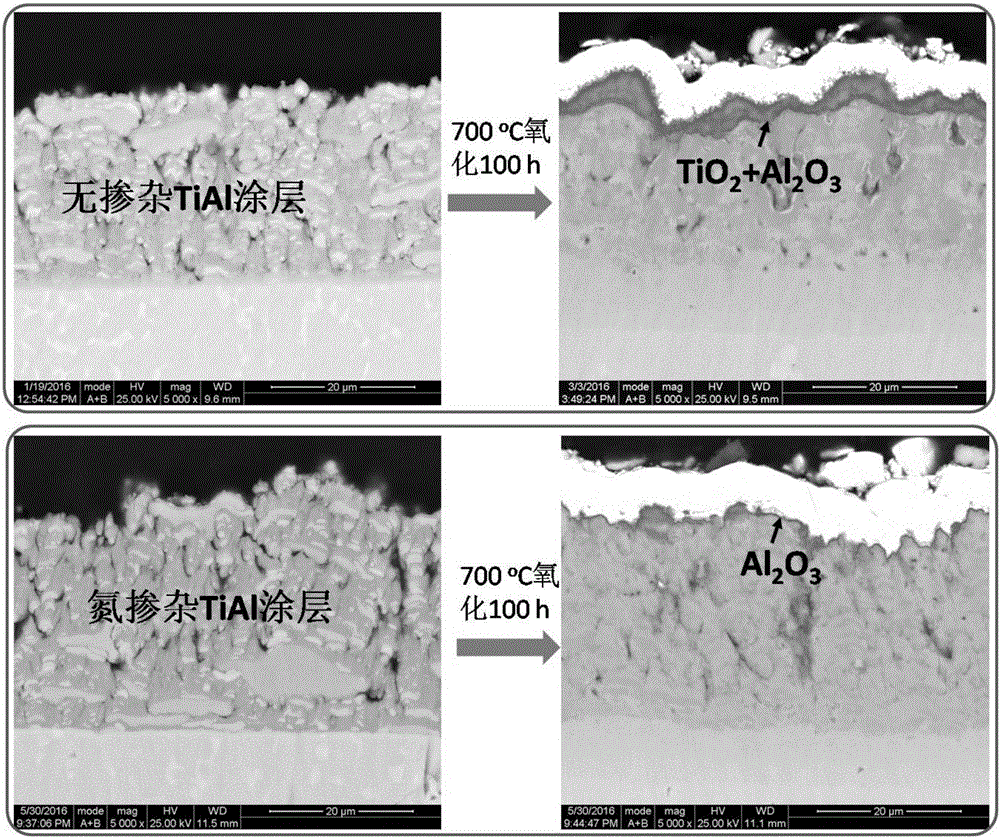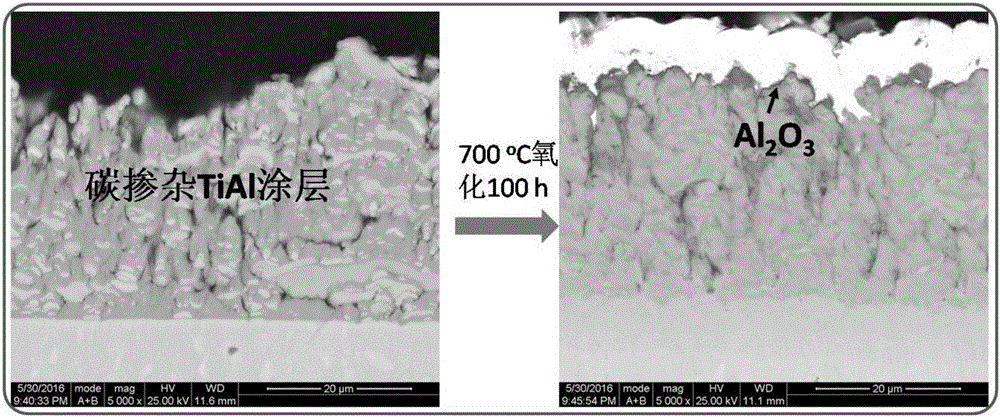TiAl coating capable of achieving heat growth of aluminum oxide film and preparing method of TiAl coating
A technology of aluminum oxide film and coating, which is applied in the field of TiAl coating of thermally grown aluminum oxide film and its preparation, can solve the problems of poor high-temperature oxidation resistance, interdiffusion, and mismatching of brittle substrates, and achieve low cost, The process is simple and controllable
- Summary
- Abstract
- Description
- Claims
- Application Information
AI Technical Summary
Problems solved by technology
Method used
Image
Examples
Embodiment 1
[0020] In this embodiment, TiAl is used as a target material to describe the preparation of a trace nitrogen-doped TiAl coating by an arc ion plating process and its preparation method. First, install the TiAl target on the cathode water-cooled target sleeve, hang the titanium alloy substrate (TC4) test piece in front of the target, close the vacuum chamber door, and perform air extraction; the vacuum degree of the coating chamber reaches 5×10 -3 When Pa or higher, ignite the cathodic arc; first, apply pulse high negative bias voltage to the substrate for ion bombardment cleaning, after cleaning, pass nitrogen gas to make the vacuum degree of the vacuum chamber reach 0.6×10 -2 Pa. The arc current is 50-400A. The current size can affect the coating deposition rate. The deposition rate is roughly linear with the current size. In this example, 70A is used, and the pulse bias is -50V. The pulsed negative bias applied to the substrate has a frequency of 40 kHz and a duty cycle of ...
Embodiment 2
[0022]In this embodiment, TiAl is used as a target material to describe the preparation of a trace nitrogen-doped TiAl coating by an arc ion plating process and its preparation method. First, install the TiAl target on the cathode water-cooled target sleeve, hang the titanium alloy substrate (TC4) test piece in front of the target, close the vacuum chamber door, and perform air extraction; the vacuum degree of the coating chamber reaches 5×10 -3 When Pa or higher, the cathodic arc is ignited; firstly, a pulsed high negative bias is applied to the substrate for ion bombardment cleaning. After cleaning, nitrogen gas is passed through to make the vacuum degree of the vacuum chamber reach 6×10 -2 Pa. The arc current was 70A, and the pulse bias was -50V. The pulsed negative bias applied to the substrate has a frequency of 40 kHz and a duty cycle of 20%. The coating time depends on the thickness of the required coating. In this example, the arc source is turned off after 2 hours f...
Embodiment 3
[0024] In this embodiment, TiAl is used as a target material to illustrate the preparation of a trace carbon-doped TiAl coating by an arc ion plating process and its preparation method. Using the same preparation process as in Example 1, the carbon-doped TiAl coating can be obtained by substituting methane for nitrogen. First, install the TiAl target on the cathode water-cooled target sleeve, hang the titanium alloy substrate (TC4) test piece in front of the target, close the vacuum chamber door, and perform air extraction; the vacuum degree of the coating chamber reaches 5×10 -3 When Pa or higher, the cathodic arc is ignited; firstly, a pulsed high negative bias is applied to the substrate for ion bombardment cleaning. After cleaning, methane is passed through to make the vacuum degree of the vacuum chamber reach 6×10 -2 Pa. The arc current was 70A, and the pulse bias was -50V. The pulsed negative bias applied to the substrate has a frequency of 40 kHz and a duty cycle of 2...
PUM
 Login to View More
Login to View More Abstract
Description
Claims
Application Information
 Login to View More
Login to View More - R&D Engineer
- R&D Manager
- IP Professional
- Industry Leading Data Capabilities
- Powerful AI technology
- Patent DNA Extraction
Browse by: Latest US Patents, China's latest patents, Technical Efficacy Thesaurus, Application Domain, Technology Topic, Popular Technical Reports.
© 2024 PatSnap. All rights reserved.Legal|Privacy policy|Modern Slavery Act Transparency Statement|Sitemap|About US| Contact US: help@patsnap.com










